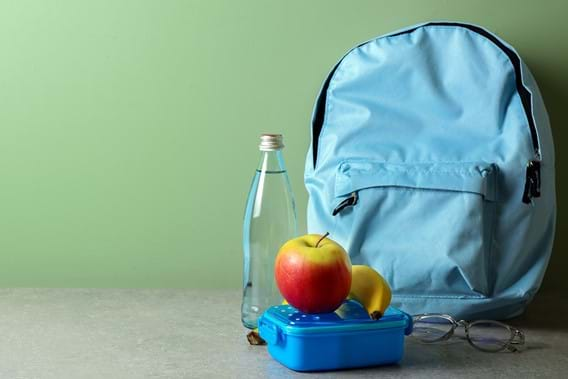
Balanced Lunches on a Budget

Written by: Marjolaine Cadieux
With the current economic situation, going thrifty whenever possible pays off. Here are some ideas and tips for preparing low-cost, balanced lunches for your children!
1. Planning
A lot of food waste happens at home. This means that your food—that you paid good money for—ends up in the trash, which is basically throwing money out the window. The first step to saving money on lunches is good planning. Will you be using the leftovers? If not, think about what you want to prepare. Planning allows to calculate exactly what you need to buy to avoid wasting!
2. Home-Cooked and Bulk Sizes
Homemade meals and snacks are often less expensive than those purchased in-store. Instead of spending on single-serve prepackaged snacks, you can prepare these yourself at home. You’ll have better control on sugar, salt and fat, and it’s a great opportunity for quality time with the kids—while saving! Cooking takes a little more time, but think of it as an investment. Buying food in larger packaging is also cost-efficient. Yogurt in individual servings may be hassle-free, but it’s more expensive and not very eco-friendly. So go for that larger sized yogurt, apple sauce, oats, bread, etc.
3. Vegetable Protein
See your tight budget as an opportunity to learn about vegetable protein. It’s ethical, better for the environment and just plain cheaper. And there’s lots of variety to boot: tofu, tempeh, red beans, lentils, chickpeas, textured vegetable protein, seitan, etc. Ideally, go for minimally processed foods (without added flavour or marinade); these have less fat and salt, and a lower price tag. Diced, washed, sliced or pickled products are always more expensive! You can take care of this step at home. Vegetable protein can replace sandwich toppings (e.g. grilled tofu, lentils or crushed chickpeas); it's delicious in bowl meals or in salads; and it’s easily incorporated to classic dishes (e.g. spaghetti sauce, shepherd’s pie). In addition, little ones (and teens too) often like the crunchy texture of roasted legumes, which make great snacks.
4. Buying Local
The current crisis has made us rethink the way we consume and spend to ensure a solid economy. So, we are increasingly turning to local products. Buying local fruits and vegetables is a good way to encourage and support local farmers, artisans and workers while saving money. This certainly requires making choices and compromises depending on the products in season, but can lead to great discoveries!
5. Fresh Foods
You want balanced lunches for your kids but the price of fresh food puts you off? Certain fresh fruits and vegetables, even local ones, can actually be too expensive for households experiencing financial strain. One solution is to opt for frozen, dried or canned foods. The texture and nutritional value of these products vary slightly, but food in this form comes cheaper and allows you to reach the recommended portions of vegetables and fruits at a low price. Ideally, once again, go for natural foods (no added sugar or salt, no syrup, etc.) whatever the type of product. As a bonus, these foods keep longer, which helps limit waste.
Finally, to prepare a sensible lunch, try to respect the “Eat Well Plate”: half made up of fruits and vegetables, one quarter of whole grain foods and one quarter of protein foods. Above all, don’t put pressure on yourself or rack your brain. Even if you sometimes have fewer vegetables or variety on the menu, it doesn’t matter. We all do the best we can in these harder times; be kind to yourself!


